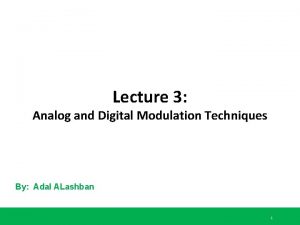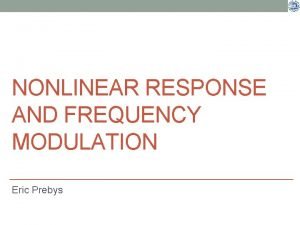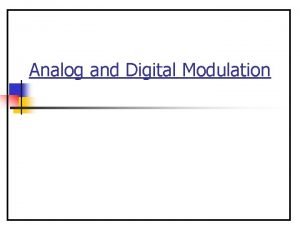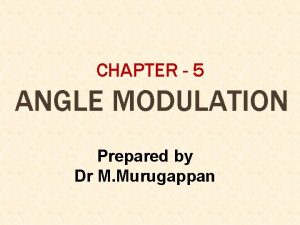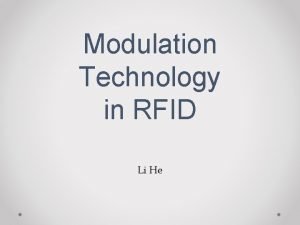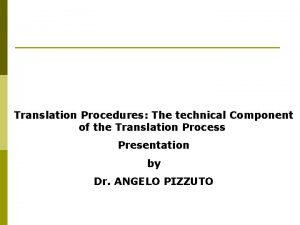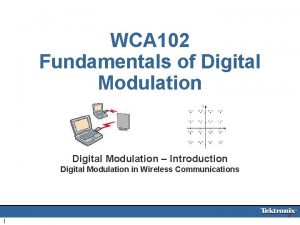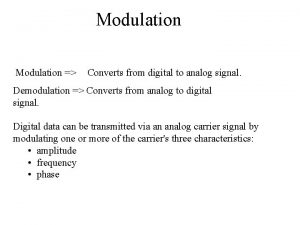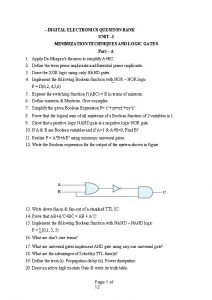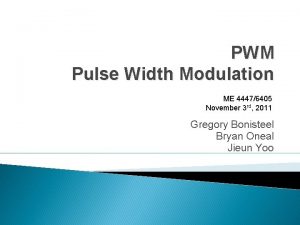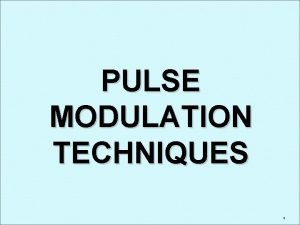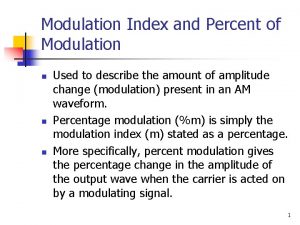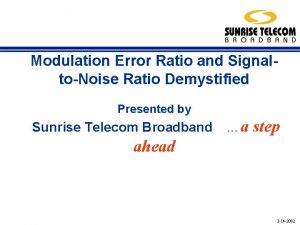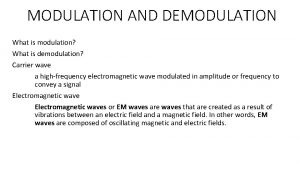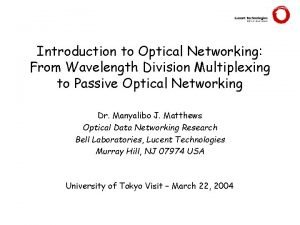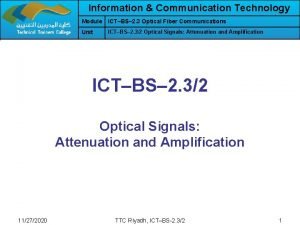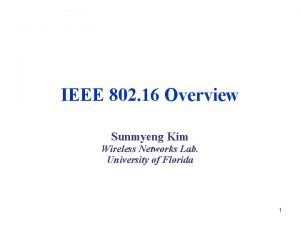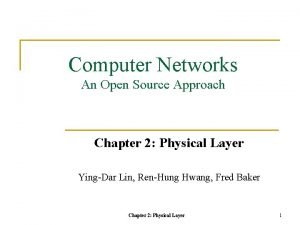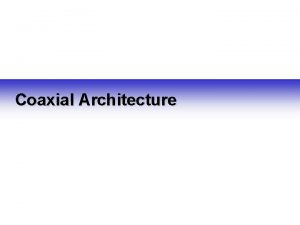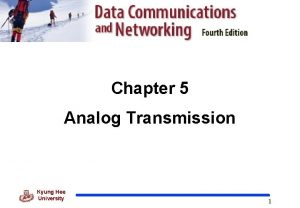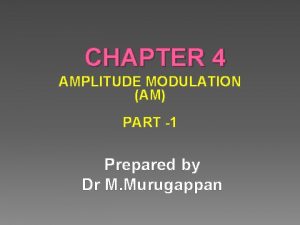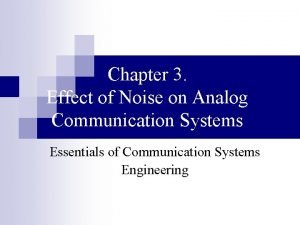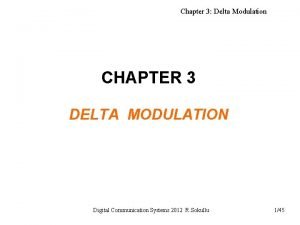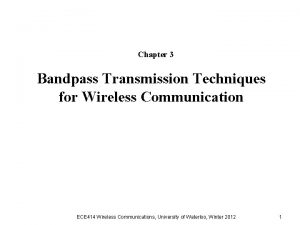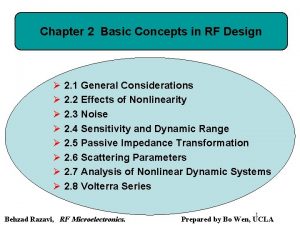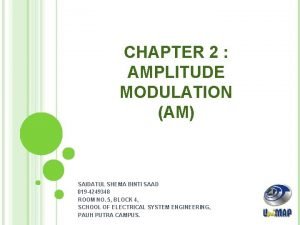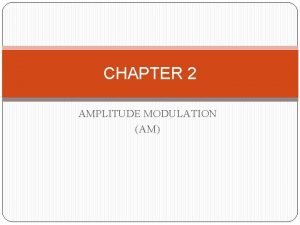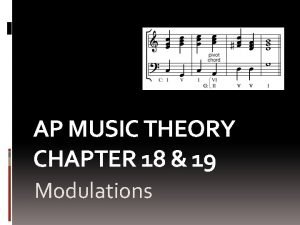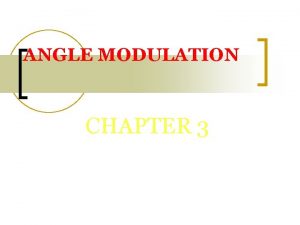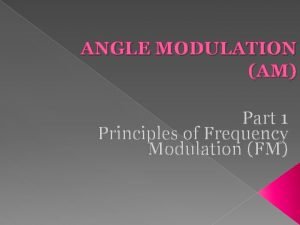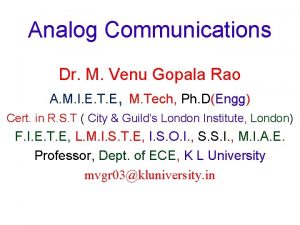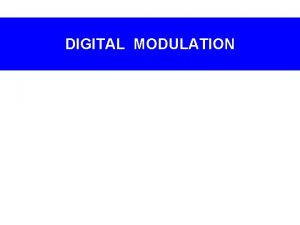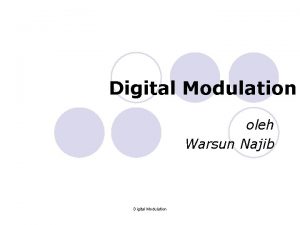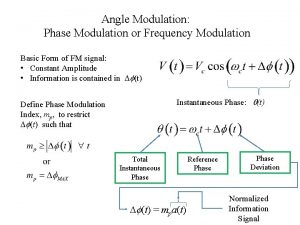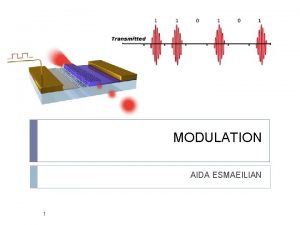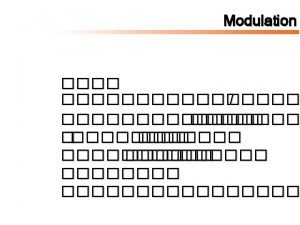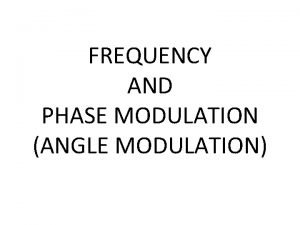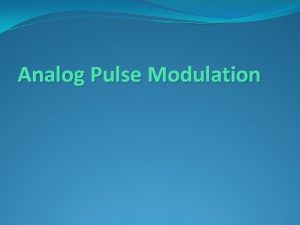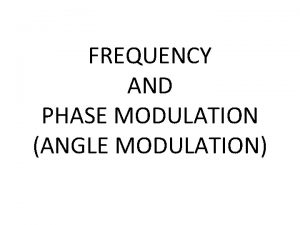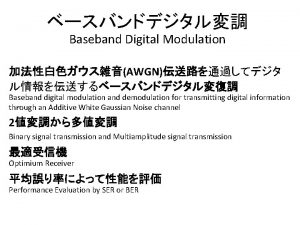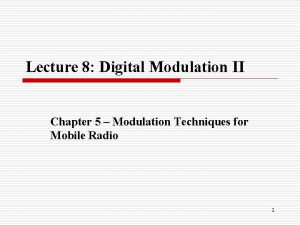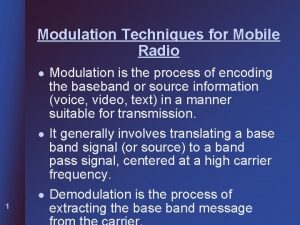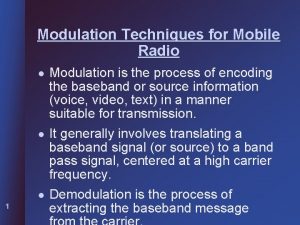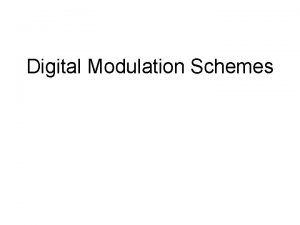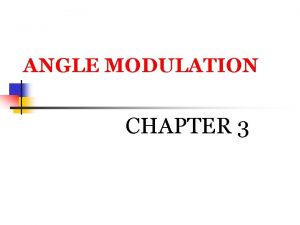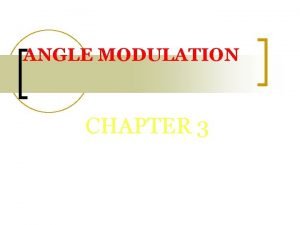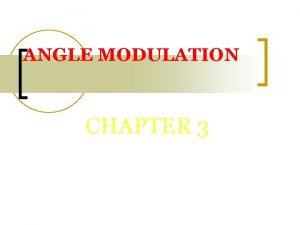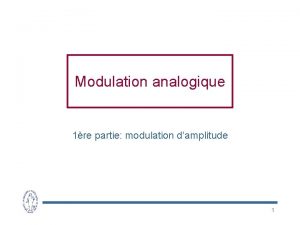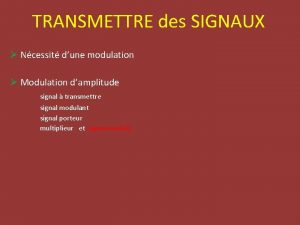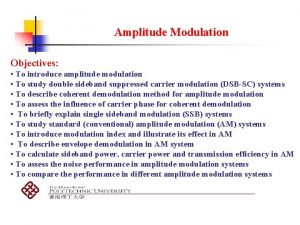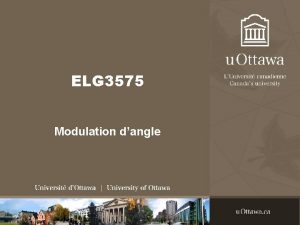Lecture 2 Part 2 A Digital Modulation Techniques














































- Slides: 46

Lecture 2 (Part 2 A) Digital Modulation Techniques PGT 313 Digital Communication Technology

Lecture Overview 2: • Baseband Data Transmission (Part 1 A, 1 B and 1 C). • Digital Modulation Techniques (Part 2 A and 2 B).

Part 2 A: Overview • Digital Modulation Techniques. • Bandpass Data Transmission: § Amplitude-Shift Keying (ASK). § Phase-Shift Keying (PSK). § Frequency-Shift Keying (FSK). § Quadrature Amplitude Modulation (QAM).

Digital Modulation Techniques • Digital modulation:

Digital Modulation Techniques A carrier signal has three parameters which can be used for impressing: s(t ) = A(t ) cos θ (t ) = ω0 t + φ (t ) ∴ s(t) = A(t) cos[ω0 t + φ (t)] Amplitude Frequency Phase

Digital Bandpass Modulation • If the amplitude, V of the carrier is varied proportional to the information signal, a digital modulated signal is called Amplitude- Shift Keying (ASK). • If the frequency, f of the carrier is varied proportional to the information signal, a digital modulated signal is called Frequency- Shift Keying (FSK).

Digital Bandpass Modulation • If the phase, θ of the carrier is varied proportional to the information signal, a digital modulated signal is called Phase -Shift Keying (PSK). • If both the amplitude and the phase, θ of the carrier are varied proportional to the information signal, a digital modulated signal is called Quadrature Amplitude Modulation (QAM).

Amplitude-Shift Keying (ASK) § ASK demonstrates poor performance, as it is heavily affected by noise and interference. § Used in radio telegraphy in the early 1900 s

Amplitude-Shift Keying (ASK) § M was chosen to be equal to 2, so it is corresponding to two waveform types. o Also know as Binary ASK (BASK) signaling (also called on-off keying)

Frequency-Shift Keying (FSK) § Bandwidth occupancy of FSK is dependant on the spacing of the two symbols. A frequency spacing of 0. 5 times the symbol period is typically used. § FSK can be expanded to a M-ary scheme, employing multiple frequencies as different states.

Frequency-Shift Keying (FSK) § M was chosen to be equal to 3, corresponding to the 3 waveform types (3 -ary). o Emphasize the mutually perpendicular axes. § The signal set is characterized by Cartesian coordinates, such that each of the mutually perpendicular axes represents a sinusoid with a different frequency. o Such mutually perpendicular vectors are called orthogonal signals.

Phase -Shift Keying (PSK) § Phase-Shift Keying (PSK) demonstrates better performance than ASK and FSK. § PSK can be expanded to a M-ary scheme, employing multiple phases and amplitudes as different states. § Filtering can be employed to avoid spectral spreading. § Widely used in both military and commercial communications system.

Phase-Shift Keying (PSK) § M was chosen as to be as 2, and it is called binary PSK (BPSK). § The modulating signal shifts the phase of the wave si(t) to one of two states, either zero or π (180º). § For the BPSK example, the vector picture illustrates the two 180º opposing vectors. § Signal sets that can be depicted with such opposing vectors are called antipodal signal sets.

Phase-Shift Keying (PSK) § Constellation of two-level PSK:

Phase-Shift Keying (PSK)

Phase-Shift Keying (PSK) § 4 -PSK o r Q u a d r a t u r e P S K ( Q P S K ) has more efficient usage of bandwidth than 2 -PSK or Binary PSK (BPSK), because each signal unit has two bits. For the same bandwidth, the data bit rate doubles.

Phase-Shift Keying (PSK) § Excellent performance of BPSK encourages us to go with QPSK.

Phase-Shift Keying (PSK) § The idea can be extended to 8 -PSK, 16 -PSK, 32 -PSK, …. § The limitation is the ability of equipment to distinguish small differences in signal’s phase. 8 PSK

BPSK Modulator § Binary PSK (BPSK) modulation can be accomplished by simply multiplying the original d(t) (which is a binary random sequence) by the carrier signal, which is an analog sinusoidal oscillation. After multiplication, a bandpass filter (BPF) is required.

QPSK Modulator

Quadrature Amplitude Modulation (QAM) § Combination of ASK and PSK which helps making a contrast between signal units. The number of amplitude shifts should be lower than the number of phase shifts due to noise susceptibility or vulnerability of ASK.

Quadrature Amplitude Modulation (QAM)

Summary

The End of Part 2 A

Lecture 2 (Part 2 B) Digital Modulation Techniques PGT 313 Digital Communication Technology

Part 2 B: Overview • Demodulation/Detection. • Coherent Detection. • Non-coherent Detection.

Demodulation/Detection § A binary bandpass system will transmit one of two waveforms, denoted s 1(t) and s 2(t). si(t) is used as a generic designation for a transmitted waveform. § The received signal r(t) degraded by noise n(t) and is rewritten as § n(t) assumed to be a zero mean AWGN process. (degradation caused by unavoidable thermal noise)

Demodulation/Detection Demodulation- Recovery of a waveform (to an undistorted pulse) Detection- decision making process of selecting the digital meaning of that waveform.

Demodulation/Detection § Step 1: § Frequency Down-Conversion o Frequency translation for signals operating at some radio frequency (RF) § Receiving Filter (Matched Filter) o To recover a pulse with the best possible signal- to-noise ratio (SNR), free of any ISI § Equalizing Filter o Compensate for the distortion caused by both the transmitter and the channel.

Demodulation/Detection § Predetection Point o Sample / test statistic z(T) that has a voltage value directly proportional to the energy of the received symbol and that of the noise. § Step 2: § Threshold Comparison o Decision is made regarding the digital meaning of that sample.

Demodulation/Detection § Coherent Detection o When the receiver exploits knowledge of the carrier’s phase to detect the signals. § Non-Coherent Detection o When the receiver does not utilize such phase reference information to detect the signals.

Coherent Detection of PSK § Consider the following binary PSK (BPSK). ϕ = arbitrary constant. E = signal energy per symbol. T = symbol duration.

Coherent Detection of PSK § Convert the antipodal case into single basis function, ψ1(t) as § Thus, express the transmitted signal, si(t) in terms of ψ1(t) and the coefficients ai 1(t) as follows:

Coherent Detection of PSK § For detection, the correlation receiver can be drawn as two product integrators, one of which is matched to s 1(t), and the other is matched to s 2(t) as shown in figure below:

Coherent Detection of PSK § Assume that s 1(t) was transmitted. Then the expected values of the product integrators with reference signals ψ1(t) , are found as o E{. } denotes the expected value.

Coherent Detection of FSK § A typical set of FSK signal waveforms as below: o E is the energy content of si(t) over each symbol duration T § Assuming that the basis functions ψ1(t) , ψ2(t), . . ψN(t) form an orthonormal set, the most useful form for {ψj(t)} is

Coherent Detection of FSK § The linear combination of N orthogonal waveforms ψ1(t), ψ2(t)…ψN(t) § These relationships are expressed in more compact notation as where

Coherent Detection of FSK § The normalizes the expected output and amplitude can be written as: § Therefore, o The ith prototype signal vector is located on the ith coordinate axis at a displacement from the origin of the original space.

Non-coherent Detection of Differential PSK § The term DPSK, refers to a detection scheme often classified as non-coherent because it does not require a reference in phase with the received carrier. § No attempt is made to determine the actual value of the phase from the incoming signal. § Therefore, if the transmitted waveform is

Non-coherent Detection of Differential PSK § Inversely we can recover ak from dk using § ak = dk ⊕ dk − 1 § If dk and dk − 1 are the same, then they represent a 1 of ak. § If dk and dk − 1 are different, they represent a 0 of ak. § The sequence {dk} is modulated onto a carrier with phase 0 or π.

Non-coherent Detection of Differential PSK

Non-coherent Detection of Differential PSK § The received signal can be characterized by o α is arbitrary constant and is typically assumed to be a random variable uniformly distributed between zero and 2π. o n(t) is an additive white Gaussian noise (AWGN) process. § If we assume that α varies slowly relative to two period times (2 T), the phase difference between two successive waveforms, θj(T 1) and θk(T 2) is independent of α; that is,

Non-coherent Detection of Differential PSK § To send the ith message (i = 1, 2, …M), the present signal waveform must have its phase advanced by ϕ i = 2πi/M radians over the previous waveform. § The detector measures the angle between the currently received signal vector and the previously received signal vector o Figure: signal space for DPSK

Non-coherent Detection of FSK § The detection hardware must be configured as an detector, without exploiting phase measurement. § In-phase (I). § Quadrature (Q). energy

Non-coherent Detection of FSK § The incoming signal will partially correlate with the cos(ω1 t) reference and partially correlate with the sin(ω1 t) reference. § The non-coherent receiver require I and Q branch for each candidate signal in the signaling set. § There are product integrators and squaring operation to prevent the appearance of any negative values. § Each signal will be added from I and Q channel respectively. § The final stage which the test statistic z(T) will be chosen based on which pair of energy detectors yield maximum output.

The End of Part 2 B
 Digital to analog modulation techniques
Digital to analog modulation techniques Amplitude modulation vs frequency modulation
Amplitude modulation vs frequency modulation Amplitude modulation vs frequency modulation
Amplitude modulation vs frequency modulation Advantages of angle modulation over amplitude modulation
Advantages of angle modulation over amplitude modulation Rfid modulation techniques
Rfid modulation techniques Direct and oblique translation
Direct and oblique translation Digital modulation advantages
Digital modulation advantages Modulation digital to analog
Modulation digital to analog Advantage and disadvantage of dpcm
Advantage and disadvantage of dpcm 01:640:244 lecture notes - lecture 15: plat, idah, farad
01:640:244 lecture notes - lecture 15: plat, idah, farad Fonctions et solutions techniques
Fonctions et solutions techniques Digital mapping techniques
Digital mapping techniques Minimization techniques in digital electronics
Minimization techniques in digital electronics Digital data communication techniques
Digital data communication techniques Part whole model subtraction
Part whole model subtraction Part to part ratio definition
Part to part ratio definition Part part whole
Part part whole Technical description examples
Technical description examples Parts of cocktail bar
Parts of cocktail bar The phase of the moon you see depends on ______.
The phase of the moon you see depends on ______. 미니탭 gage r&r 해석
미니탭 gage r&r 해석 Tina champagne sensory modulation and environment
Tina champagne sensory modulation and environment Trail edge modulation
Trail edge modulation Pulse code modulation conclusion
Pulse code modulation conclusion Percentage of modulation formula
Percentage of modulation formula Modulation error ratio
Modulation error ratio Applications of amplitude modulation
Applications of amplitude modulation Biomechanische prinzipien schwimmen
Biomechanische prinzipien schwimmen Cross phase modulation
Cross phase modulation Direct modulation
Direct modulation Ssin-802
Ssin-802 Example of experience corollary
Example of experience corollary Ask modulation constellation diagram
Ask modulation constellation diagram Hfc trunks
Hfc trunks Ask modulation constellation diagram
Ask modulation constellation diagram Principles of amplitude modulation
Principles of amplitude modulation White noise in analog communication
White noise in analog communication Demodulation of delta modulation
Demodulation of delta modulation Ask modulation constellation diagram
Ask modulation constellation diagram Cross modulation
Cross modulation Modulation envelope
Modulation envelope Principle of am
Principle of am Sequential modulation
Sequential modulation Formula for modulation index
Formula for modulation index Formula for modulation index
Formula for modulation index Modulacion
Modulacion What is the modulation of severn suzuki speech
What is the modulation of severn suzuki speech
